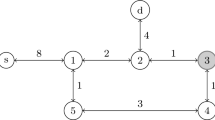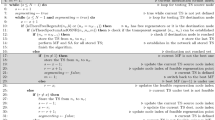Abstract
We discuss the problem of designing translucent optical networks composed of restorable, transparent subnetworks interconnected via transponders. We develop an integer linear programming (ILP) formulation for partitioning an optical network topology into subnetworks, where the subnetworks are determined subject to the constraints that each subnetwork satisfies size limitations, and it is two-connected. A greedy heuristic partitioning algorithm is proposed for planar network topologies. We use section restoration for translucent networks where failed connections are rerouted within the subnetwork which contains the failed link. The network design problem of determining working and restoration capacities with section restoration is formulated as an ILP problem. Numerical results show that fiber costs with section restoration are close to those with path restoration for mesh topologies used in this study. It is also shown that the number of transponders with the translucent network architecture is substantially reduced compared to opaque networks.
Similar content being viewed by others
References
S. B. Alexander, et al., A precompetitive consortium on wideband all-optical networks, IEEE/OSA Journal of Lightwave Technology, vol. 11, no. 5/6, (May/June 1993), pp. 714-735.
R. E. Wagner, et al., MONET: Multiwavelength optical networking, IEEE/OSA Journal of Lightwave Technology, vol. 14, no. 6, (June 1996), pp. 1349-1355.
J. M. H. Elmirghani, H. T. Mouftah, All-optical wavelength conversion: Technologies and applications in DWDM networks, IEEE Communications Magazine, vol. 38, no. 3, (March 2000), pp. 86-92.
E. Karasan, E. Ayanoglu, Performance of WDM transport networks, IEEE Journal on Selected Areas in Communications, vol. 16, no. 7, (Sept. 1998), pp. 1081-1096.
J. M. Yates, M. P. Rumsewicz, J. P. R. Lacey, Wavelength converters in dynamically-reconfigurable WDM networks, IEEE Communication Surveys, Second Quarter (1999), pp. 2-15.
B. Ramamurthy, B. Mukherjee, Wavelength conversion in WDM networking, IEEE Journal on Selected Areas in Communications, vol. 16, no. 7, (Sept. 1998), pp. 1061-1073.
K. Bala, R. Cordell, E. Goldstein, The case for opaque multiwavelength lightwave networks, Proceedings of IEEE/LEOS Summer Topical Meeting on Global Information Infrastructure, (Keystone, CO, Aug. 1995).
P. Green, Progress in optical networking, IEEE Communications Magazine, vol. 39, no. 1, (Jan. 2001), pp. 54-61.
B. Ramamurthy, et al., Transparent vs. opaque vs. translucent wavelength-routed optical networks, Technical Digest, Optical Fiber Communication (OFC'99), (San Diego, CA, Feb. 1999), pp. 59-61.
B. Rajagopalan, et al., IP over optical networks: Architectural aspects, IEEE Communications Magazine, vol. 38, no. 9, (Sept. 2000), pp. 94-102.
J. Strand, A. L. Chiu, R. Tkach, Issues for routing in the optical layer, IEEE Communications Magazine, vol. 39, no. 2, (Feb. 2001), pp. 81-87.
E. Yetginer, E. Karasan, Regenerator placement and traffic engineering with restoration in GMPLS networks, Photonic Network Communications, vol. 6, no. 2, (Sept. 2003), pp. 139-149.
C. Ou, H. Zang, B. Mukherjee, Sub-path protection for scalability and fast recovery in WDM mesh networks, Technical Digest, Optical Fiber Communication (OFC'2002), (Anaheim, CA, March 2002), pp. 495-496.
P.-H. Ho, H. Mouftah, A framework for service-guaranteed shared protection in WDM mesh networks, IEEE Communications Magazine, vol. 40, no. 2, (Feb. 2002), pp. 97-103.
M. Alanyali, E. Ayanoglu, Provisioning algorithms for WDM optical networks, IEEE/ACM Transactions on Networking, vol. 7, no. 5, (Oct. 1999), pp. 767-778.
G. Mohan, C. S. R. Murthy, Lightpath restoration in WDM optical networks, IEEE Network, vol. 14, (Nov./Dec. 2000), pp. 24-32.
R. R. Iraschko, W. D. Grover, A highly efficient path-restoration protocol for management of optical network transport integrity, IEEE Journal on Selected Areas in Communications, vol. 18, no. 5, (May 2000), pp. 779-794.
B. T. Doshi, et al., Optical network design and restoration, Bell Labs Technical Journal, vol. 4, no. 1, (Jan.–March 1999), pp. 58-84.
R. K. Ahuja, T. L. Magnanti, J. B. Orlin, Network Flows (Prentice Hall, New Jersey, 1993).
Béla Bollobás, Graph Theory (Springer-Verlag, New York, 1979).
T. Nishizeki, N. Chiba, Planar Graphs: Theory and Algorithms
Author information
Authors and Affiliations
Corresponding author
Rights and permissions
About this article
Cite this article
Karasan, E., Arisoylu, M. Design of Translucent Optical Networks: Partitioning and Restoration. Photonic Network Communications 8, 209–221 (2004). https://doi.org/10.1023/B:PNET.0000033979.26662.f4
Issue Date:
DOI: https://doi.org/10.1023/B:PNET.0000033979.26662.f4




